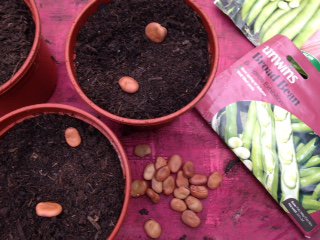 I have come to believe that the way to succeed with broad beans is to sow them every which way: autumn in the ground under cloches, winter in the greenhouse, spring direct and with no protection. Sow only in autumn and there will follow an extremely hard winter to knock the stuffing out of them. Sow only in spring and they will be blackened by a hard, late frost, or be blown over in spring gales. It’s not that I have never succeeded with broad beans, but when I have it has always felt an entirely random success, dependent on luck rather than planning or good gardening practice. There is always a perfect moment in which to sow your broad beans, but you never know what it is until after winter, so now I just line em up and let winter and early spring knock em down, then count my survivors when it’s all over.
I have come to believe that the way to succeed with broad beans is to sow them every which way: autumn in the ground under cloches, winter in the greenhouse, spring direct and with no protection. Sow only in autumn and there will follow an extremely hard winter to knock the stuffing out of them. Sow only in spring and they will be blackened by a hard, late frost, or be blown over in spring gales. It’s not that I have never succeeded with broad beans, but when I have it has always felt an entirely random success, dependent on luck rather than planning or good gardening practice. There is always a perfect moment in which to sow your broad beans, but you never know what it is until after winter, so now I just line em up and let winter and early spring knock em down, then count my survivors when it’s all over.
And so following this mantra I sowed some broad beans in autumn, straight into the ground, and with a new twist this year: I pushed the seeds into the ground in among some self-sown claytonia. The seedlings grew up nestled among protective foliage and are particularly big and strong now. This may be a technique that I shall have to add to my broad bean arsenal, but I have also done well in the past with sowing and covering with fleece. As with all broad bean growing this will work some years and not others: one year a heavy snowfall meant all of the plants under fleece were squashed and snapped. But it’s just one more technique that just might yield results.
And I am also sowing some now, in the greenhouse. I have an allotment neighbour who appears to have none of my broad-bean-based troubles. Every year he has big, handsome broad bean plants brimming with beans. He should do really. He is one of those allotment holders who only grows three crops (runner beans, broad beans, tomatoes, in his case) and if you are going to specialise to quite that extent, you’d better be able to grow your appointed vegetables pretty well. It has taken me a few years to get around to asking him his secret (we are generally more on grunting and nodding terms than chatting) but last year I finally did. He sows them in January and February in his greenhouse each year and plants them out as soon as they are big enough. It certainly seems to work for him and so this year I am copying. I chose the variety Bunyard’s Exhibition, which is an old (at least 100 years in cultivation) and very reliable cultivar. With all my past troubles, reliable is what I want. I have sown them in big pots, two to a pot, as I know that they quickly outgrow modules once they get going. I will plant them out once they look big enough to fend for themselves, perhaps around March as the weather starts to ease, and I will sow a few more direct as I do so.
It all may seem a lot of trouble to go to, but a surfeit of broad beans is a marvellous thing, coming as it does at such a lean time. The kids eat them raw. I mash them (popped out of both shells of course, time consuming but worth it) into purees with mint and crème fraiche, or I warm them through with crispy nuggets of bacon, child pleasingly. They are a crop most perfectly suited to spring, but that requires a little bit of attention and dedication through autumn and winter.


